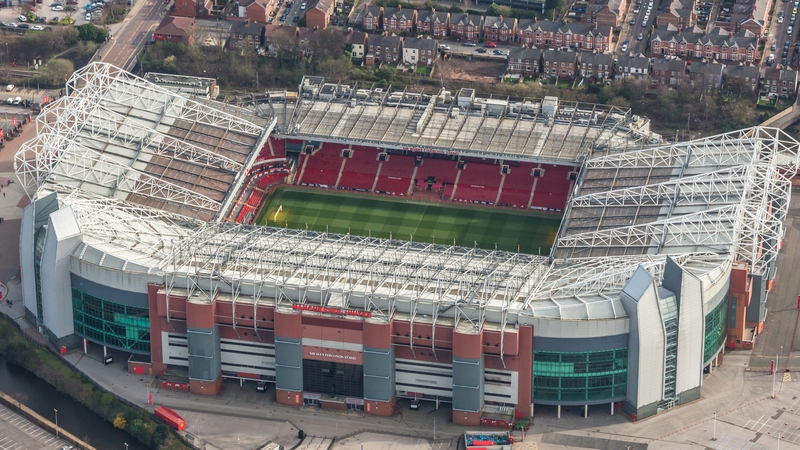Updated / Wednesday, 23 Nov 2022

Old Trafford, the home of Manchester United
Manchester United said it was starting a process to explore strategic alternatives, including a new investment or a potential sale.
This comes 17 years after the American Glazer family bought the English Premier League soccer club.
The Glazer family is working with financial advisers on the process, which could lead to a partial sale of the Old Trafford club or investments including stadium and infrastructure redevelopment, the club said in a statement.
Man Utd fans have been clamouring for a change of ownership and the Glazers have been the target of intense criticism as the team have gone five years without winning a trophy.
The last silverware they won was the Europa League and League Cup back in 2017.
"As we seek to continue building on the club's history of success, the board has authorised a thorough evaluation of strategic alternatives," Avram Glazer and Joel Glazer, executive co-chairmen and directors of United, said in the statement.
"We will evaluate all options to ensure that we best serve our fans and that Manchester United maximizes the significant growth opportunities available to the club today and in the future," the statement said.
In August, British billionaire Jim Ratcliffe had expressed interest in buying United, Reuters reported. At the time, Elon Musk had also joked about planning to buy the club.
Wealthy Asian tycoons, especially those from China, have been buying European teams in recent years including Premier League side Wolverhampton Wanderers and Italy's Inter Milan.
But football clubs have since been deemed unfavourable assets by China and any major overseas purchase would seem unlikely at the moment, said Mark Dreyer, author of "Sporting Superpower", a book about China's sports ambitions.
"It's almost impossible to see how any Chinese-related entity could justify a purchase of this magnitude in the current climate," he said.
The owners are under pressure with United sitting fifth in the Premier League halfway through the season, which has been suspended because of the current Qatar World Cup.
Manchester United shares jumped as much as 20% after Sky News first reported on the sale process, giving the club a market capitalisation of $2.6 billion.
The company was worth $2.5 billion at the close of US trading last night. At its peak as a public company, it had a market capitalisation of $4.3 billion in 2018.
The club also said yesterday that star striker Cristiano Ronaldo will leave with immediate effect, marking a bitter end to the Portugal captain's second spell at Old Trafford after he said he felt betrayed by the club.
The Glazers bought the club for £790m in 2005 in a highly leveraged deal which has been criticised for loading debt onto the club.
United has been listed on the New York Stock Exchange since 2012, when the Glazers sold 10% of their holding via the listing and have sold more shares since.
Among the fan protests against the Glazers was one in May 2021 that forced the postponement of a home match against Liverpool, one of the club's biggest rivals. It was the first Premier League match to be postponed because of a protest.
United and Liverpool were among a group of big clubs that said they wanted to establish a European Super League in April 2021 but then withdrew, partly because of objections from many fans in England.
Liverpool are also "exploring a sale" according to club chairman Tom Werner.
In May 2022, Chelsea Football Club was sold to a consortium led by an investment group fronted by Todd Boehly and Clearlake Capital for £2.5 billion.
United finished sixth last season in their worst Premier League campaign in terms of points earned, failing to qualify for the lucrative European Champions League competition.
They won the last of their record 20 top-flight league titles in 2013, the year the great Alex Ferguson stepped down as manager after more than 26 years in charge.
The club have hired Dutch manager Erik ten Hag from Ajax Amsterdam in a bid to turn around their fortunes.
Manchester United said it was starting a process to explore strategic alternatives, including a new investment or a potential sale.
This comes 17 years after the American Glazer family bought the English Premier League soccer club.
The Glazer family is working with financial advisers on the process, which could lead to a partial sale of the Old Trafford club or investments including stadium and infrastructure redevelopment, the club said in a statement.
Man Utd fans have been clamouring for a change of ownership and the Glazers have been the target of intense criticism as the team have gone five years without winning a trophy.
The last silverware they won was the Europa League and League Cup back in 2017.
"As we seek to continue building on the club's history of success, the board has authorised a thorough evaluation of strategic alternatives," Avram Glazer and Joel Glazer, executive co-chairmen and directors of United, said in the statement.
"We will evaluate all options to ensure that we best serve our fans and that Manchester United maximizes the significant growth opportunities available to the club today and in the future," the statement said.
In August, British billionaire Jim Ratcliffe had expressed interest in buying United, Reuters reported. At the time, Elon Musk had also joked about planning to buy the club.
Wealthy Asian tycoons, especially those from China, have been buying European teams in recent years including Premier League side Wolverhampton Wanderers and Italy's Inter Milan.
But football clubs have since been deemed unfavourable assets by China and any major overseas purchase would seem unlikely at the moment, said Mark Dreyer, author of "Sporting Superpower", a book about China's sports ambitions.
"It's almost impossible to see how any Chinese-related entity could justify a purchase of this magnitude in the current climate," he said.
The owners are under pressure with United sitting fifth in the Premier League halfway through the season, which has been suspended because of the current Qatar World Cup.
Manchester United shares jumped as much as 20% after Sky News first reported on the sale process, giving the club a market capitalisation of $2.6 billion.
The company was worth $2.5 billion at the close of US trading last night. At its peak as a public company, it had a market capitalisation of $4.3 billion in 2018.
The club also said yesterday that star striker Cristiano Ronaldo will leave with immediate effect, marking a bitter end to the Portugal captain's second spell at Old Trafford after he said he felt betrayed by the club.
The Glazers bought the club for £790m in 2005 in a highly leveraged deal which has been criticised for loading debt onto the club.
United has been listed on the New York Stock Exchange since 2012, when the Glazers sold 10% of their holding via the listing and have sold more shares since.
Among the fan protests against the Glazers was one in May 2021 that forced the postponement of a home match against Liverpool, one of the club's biggest rivals. It was the first Premier League match to be postponed because of a protest.
United and Liverpool were among a group of big clubs that said they wanted to establish a European Super League in April 2021 but then withdrew, partly because of objections from many fans in England.
Liverpool are also "exploring a sale" according to club chairman Tom Werner.
In May 2022, Chelsea Football Club was sold to a consortium led by an investment group fronted by Todd Boehly and Clearlake Capital for £2.5 billion.
United finished sixth last season in their worst Premier League campaign in terms of points earned, failing to qualify for the lucrative European Champions League competition.
They won the last of their record 20 top-flight league titles in 2013, the year the great Alex Ferguson stepped down as manager after more than 26 years in charge.
The club have hired Dutch manager Erik ten Hag from Ajax Amsterdam in a bid to turn around their fortunes.
Manchester United for sale after Cristiano Ronaldo exit on day of drama at Old Trafford

Time up: Cristiano Ronaldo leaves Manchester United
James Ducker
November 23 2022 02:30 AM
The Glazer family are exploring the potential sale of Manchester United after a dramatic day of developments at Old Trafford that saw Cristiano Ronaldo exit the club with immediate effect.
Following the news of the Portugal star’s departure, it emerged that United’s controversial owners have consulted investment bankers to explore their financial options, including a full or partial sale of one of the world’s most famous clubs.
Last night United released a statement saying that the board “is commencing a process to explore strategic alternatives for the club.”
The statement went on: “The process is designed to enhance the club’s future growth, with the ultimate goal of positioning the club to capitalise on opportunities both on the pitch and commercially. As part of this process, the Board will consider all strategic alternatives, including new investment into the club, a sale, or other transactions involving the Company.”
The news comes barely a fortnight after it was reported that Fenway Sports Group (FSG), the American owners of Liverpool, had put the Merseyside club up for sale. FSG and the Glazers had been driving forces behind the failed European Super League (ESL) plot, which collapsed amid a furious backlash last year.

Read More
James Ducker
November 23 2022 02:30 AM
The Glazer family are exploring the potential sale of Manchester United after a dramatic day of developments at Old Trafford that saw Cristiano Ronaldo exit the club with immediate effect.
Following the news of the Portugal star’s departure, it emerged that United’s controversial owners have consulted investment bankers to explore their financial options, including a full or partial sale of one of the world’s most famous clubs.
Last night United released a statement saying that the board “is commencing a process to explore strategic alternatives for the club.”
The statement went on: “The process is designed to enhance the club’s future growth, with the ultimate goal of positioning the club to capitalise on opportunities both on the pitch and commercially. As part of this process, the Board will consider all strategic alternatives, including new investment into the club, a sale, or other transactions involving the Company.”
The news comes barely a fortnight after it was reported that Fenway Sports Group (FSG), the American owners of Liverpool, had put the Merseyside club up for sale. FSG and the Glazers had been driving forces behind the failed European Super League (ESL) plot, which collapsed amid a furious backlash last year.

Read More
Erik ten Hag wins Ronaldo battle – now it’s time to win some trophies
Cristiano Ronaldo ready for ‘a new challenge’ as Man Utd terminate his contract
From interview to exit, how Cristiano Ronaldo’s Man Utd departure unfolded
Speculation that the Glazers could sell United has been rife for years and their 17-year ownership of the club has been marked by decline on the pitch and long-standing fan protests.
The prospect of a sale would be welcomed by many United supporters, who have campaigned for the Americans’ removal. Jim Ratcliffe, the billionaire majority shareholder of chemical group Ineos who has supported United since childhood, said last month that the Glazers told him they did not want to sell the club.
Indeed, it remains possible that the family – who bought United in a highly leveraged takeover in May 2005 that was fiercely protested by fans at the time and led to some supporters forming a breakaway club – may decide not to sell and could instead pursue fresh investment.
United are currently exploring the possibility of redeveloping Old Trafford. There is also a possibility that any capital raised could be put towards funding such a project.
The Glazers vowed to consult more with fans in the wake of the ESL collapse and acknowledged the need for “significant investment” in Old Trafford.
United were valued at $2.15billion (€2.1bn) as trading closed on the New York Stock Exchange, but there is an expectation the club would be sold for substantially more, if it ever got to that stage.
Meanwhile, it emerged that Ronaldo will not receive a penny in compensation from United after his dramatic departure from the club.
Less than 48 hours before Portugal’s opening World Cup match against Ghana, United issued a statement confirming Ronaldo had left the club by mutual agreement with immediate effect.
The announcement comes in the wake of the Portugal striker’s bombshell interview last week, in which he infuriated United by launching blistering attacks on manager Erik ten Hag, the Glazers and the way the club is run.
United were determined to ditch Ronaldo without a pay-off, in the belief he had breached his contract, and it is understood that the player will walk away with nothing.
Ronaldo had stood to earn up to another £17million (€19.6m) from a contract that ran until the end of the season.
United were keen for a swift and clean resolution and to avoid a long legal battle with the five-time World Player of the Year and got their wishes after talks between lawyers for both parties and Old Trafford chief executive Richard Arnold and Ronaldo’s agent Jorge Mendes.
Ronaldo’s exit marks a sad and ugly end to the player’s second spell at Old Trafford as what was billed as a dream “homecoming” turned into a nightmare.
The departure will ramp up the pressure on the 37-year-old free agent to deliver for Portugal at the World Cup as he looks for a new club.
United made no reference to Ronaldo’s incendiary interview in a 67-word statement released yesterday evening and instead opted for a dignified tone as they thanked the renegade striker for his “immense contribution” over two spells with the club.
“The club thanks him for his immense contribution, and wishes him and his family well for the future. Everyone at Manchester United remains focused on continuing the team’s progress under Erik ten Hag and working together to deliver success on the pitch.”
Cristiano Ronaldo ready for ‘a new challenge’ as Man Utd terminate his contract
From interview to exit, how Cristiano Ronaldo’s Man Utd departure unfolded
Speculation that the Glazers could sell United has been rife for years and their 17-year ownership of the club has been marked by decline on the pitch and long-standing fan protests.
The prospect of a sale would be welcomed by many United supporters, who have campaigned for the Americans’ removal. Jim Ratcliffe, the billionaire majority shareholder of chemical group Ineos who has supported United since childhood, said last month that the Glazers told him they did not want to sell the club.
Indeed, it remains possible that the family – who bought United in a highly leveraged takeover in May 2005 that was fiercely protested by fans at the time and led to some supporters forming a breakaway club – may decide not to sell and could instead pursue fresh investment.
United are currently exploring the possibility of redeveloping Old Trafford. There is also a possibility that any capital raised could be put towards funding such a project.
The Glazers vowed to consult more with fans in the wake of the ESL collapse and acknowledged the need for “significant investment” in Old Trafford.
United were valued at $2.15billion (€2.1bn) as trading closed on the New York Stock Exchange, but there is an expectation the club would be sold for substantially more, if it ever got to that stage.
Meanwhile, it emerged that Ronaldo will not receive a penny in compensation from United after his dramatic departure from the club.
Less than 48 hours before Portugal’s opening World Cup match against Ghana, United issued a statement confirming Ronaldo had left the club by mutual agreement with immediate effect.
The announcement comes in the wake of the Portugal striker’s bombshell interview last week, in which he infuriated United by launching blistering attacks on manager Erik ten Hag, the Glazers and the way the club is run.
United were determined to ditch Ronaldo without a pay-off, in the belief he had breached his contract, and it is understood that the player will walk away with nothing.
Ronaldo had stood to earn up to another £17million (€19.6m) from a contract that ran until the end of the season.
United were keen for a swift and clean resolution and to avoid a long legal battle with the five-time World Player of the Year and got their wishes after talks between lawyers for both parties and Old Trafford chief executive Richard Arnold and Ronaldo’s agent Jorge Mendes.
Ronaldo’s exit marks a sad and ugly end to the player’s second spell at Old Trafford as what was billed as a dream “homecoming” turned into a nightmare.
The departure will ramp up the pressure on the 37-year-old free agent to deliver for Portugal at the World Cup as he looks for a new club.
United made no reference to Ronaldo’s incendiary interview in a 67-word statement released yesterday evening and instead opted for a dignified tone as they thanked the renegade striker for his “immense contribution” over two spells with the club.
“The club thanks him for his immense contribution, and wishes him and his family well for the future. Everyone at Manchester United remains focused on continuing the team’s progress under Erik ten Hag and working together to deliver success on the pitch.”


:quality(70)/cloudfront-eu-central-1.images.arcpublishing.com/thenational/C3YSQJU6VG7OIL5X3YEIEOON6U.jpg)
:quality(70)/cloudfront-eu-central-1.images.arcpublishing.com/thenational/TUK2ZJD6OMN6GMKEJNOADDZ5XQ.jpg)
:quality(70)/cloudfront-eu-central-1.images.arcpublishing.com/thenational/QXGRYWO2N5TSFFQFY5JP4VAC64.jpg)
:quality(70)/cloudfront-eu-central-1.images.arcpublishing.com/thenational/AC4WTJIQE4DTHVAKLESTZG5Q6A.jpg)
:quality(70)/cloudfront-eu-central-1.images.arcpublishing.com/thenational/JMHSTN4DSW3RQUIPJCX3Z7CCWE.jpg)
:quality(70)/cloudfront-eu-central-1.images.arcpublishing.com/thenational/XCWED5EYNU5WH3CU23CNISIUBA.jpg)
:quality(70)/cloudfront-eu-central-1.images.arcpublishing.com/thenational/WRJ4AWPQN5KWXJNTVAUOIYSEUA.jpg)
:quality(70)/cloudfront-eu-central-1.images.arcpublishing.com/thenational/6EZSGLSLOSIBSRZSR3A4UF7NAU.jpg)
:quality(70)/cloudfront-eu-central-1.images.arcpublishing.com/thenational/5HPZ4JPTHW72UZG5YBI37LZQ2U.jpg)
:quality(70)/cloudfront-eu-central-1.images.arcpublishing.com/thenational/BYXBIHXRAQZSHQEYQQDZCWDX5U.jpg)
:quality(70)/cloudfront-eu-central-1.images.arcpublishing.com/thenational/K5XU5Q3RXGTJRAMZ7KXT4NQ3YU.jpg)
:quality(70)/cloudfront-eu-central-1.images.arcpublishing.com/thenational/RM6BJHHTHOCNTS7OUY4YA3YJLE.jpg)
:quality(70)/cloudfront-eu-central-1.images.arcpublishing.com/thenational/TONV5BTVVBSBTVJPRF36VCOP7Y.jpg)
:quality(70)/cloudfront-eu-central-1.images.arcpublishing.com/thenational/6WCYEKWBR4YOL4M2BGNHRUXEBI.jpg)
:quality(70)/cloudfront-eu-central-1.images.arcpublishing.com/thenational/KYEO2PNDE3ENXY6EAARTMVOEHU.jpg)
:quality(70)/cloudfront-eu-central-1.images.arcpublishing.com/thenational/BEXQN4IJ6LZITPZOELGV55M3RQ.jpg)
:quality(70)/cloudfront-eu-central-1.images.arcpublishing.com/thenational/LGMZOFISGN6KPRIVYUOQHZQCU4.jpg)
:quality(70)/cloudfront-eu-central-1.images.arcpublishing.com/thenational/HWSOPP7FEBN2AZRDC5X565F3BA.jpg)
:quality(70)/cloudfront-eu-central-1.images.arcpublishing.com/thenational/CTZWNVBJ2FRMOQTFCX6ARVH4EI.jpg)
















